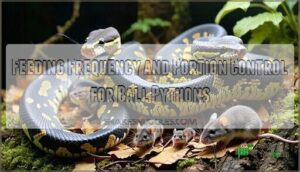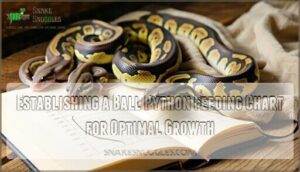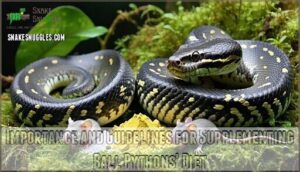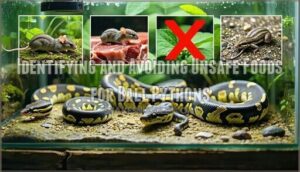This site is supported by our readers. We may earn a commission, at no cost to you, if you purchase through links.
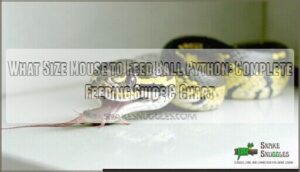 When deciding what size mouse to feed ball python, you’ll want the prey to weigh 10-15% of your snake’s body weight.
When deciding what size mouse to feed ball python, you’ll want the prey to weigh 10-15% of your snake’s body weight.
For juveniles, start with fuzzy mice and work up to adult mice as they grow.
The mouse shouldn’t be wider than your python’s thickest part – think of it as finding the right-sized sweater.
A baby ball python typically needs hoppers or small adult mice, while full-grown adults can handle large adult mice.
You’ll know you’ve got it right when the mouse creates a slight bulge after swallowing but doesn’t stretch your snake uncomfortably.
Getting this balance prevents serious feeding complications, ensuring a healthy and safe feeding practice.
Table Of Contents
- Key Takeaways
- What Size Mouse to Feed Ball Python?
- Suitable Mouse Sizes for Ball Python Feeding
- Risks of Feeding Your Ball Python Oversized Mice
- Feeding Frequency and Portion Control for Ball Pythons
- Appropriate Rat Sizes for Hatchling Ball Pythons
- Establishing a Ball Python Feeding Chart for Optimal Growth
- Importance and Guidelines for Supplementing Ball Pythons’ Diet
- Identifying and Avoiding Unsafe Foods for Ball Pythons
- Frequently Asked Questions (FAQs)
- What size prey should I feed my ball python?
- What size rat for 400 gram ball python?
- Can a ball python eat 2 small mice?
- Can a ball python eat an adult rat?
- What size mice to feed my ball python?
- What happens if I feed my ball python too big of a mouse?
- Can you feed a ball python 2 mice in one day?
- What size rat to feed hatchling ball python?
- Can ball pythons eat insects?
- How to switch from live to frozen prey?
- Conclusion
Key Takeaways
- You’ll want to feed your ball python mice that weigh 10-15% of your snake’s body weight – this prevents digestive issues and ensures proper nutrition without overfeeding.
- Choose prey that’s no wider than your python’s thickest body section – if the mouse is too large, it can cause regurgitation, impaction, or other serious health complications.
- Start hatchlings with hopper mice and gradually increase to fuzzy mice by 3 months, then small adult mice by 6 months as your snake grows and develops.
- Feed juveniles every 5-7 days and adults every 10-14 days – consistent feeding schedules based on your python’s age help maintain healthy growth and prevent obesity.
What Size Mouse to Feed Ball Python?
The right mouse size for your ball python depends on your snake’s girth. Choose prey that’s no wider than the thickest part of your python’s body. Hatchlings need hopper mice, while three-month-old snakes can handle fuzzy mice. By six months, small adult mice work well.
Mouse weight should match your snake’s prey diameter needs. Oversized prey creates regurgitation risk and digestive problems. Always measure your python’s girth before selecting appropriate mouse size.
Use feeding tongs to offer frozen-thawed mice safely. Feed juveniles every 5-10 days and adults every 10-14 days. A good rule of thumb is to feed based on ball python growth stages.
Getting snake food size right prevents impaction and keeps your python healthy. Your snake will thrive when you match python prey size to its body dimensions.
Suitable Mouse Sizes for Ball Python Feeding
Choosing the right mouse size for your ball python isn’t guesswork. You’ll need to match mouse weight to your snake’s development stage and snake girth.
Hatchlings start with pinky mice, which are tiny and easy to digest. As your python grows, progress to fuzzy mice around three months old. By six months, most pythons handle small adult mice comfortably.
The golden rule: prey size should never exceed your snake’s widest body section. Appropriate mouse size equals roughly 10-15% of your python’s total weight. Snake food size that’s too large causes serious digestive problems.
Frozen vs. live prey both work, though frozen offers better safety and convenience. Scenting prey with mouse bedding can encourage reluctant feeders. This feeding progression guarantees steady growth while preventing health complications.
For hatchlings, pinkie mice are easily digestible.
Stick to this python prey size formula, and you’ll keep your snake healthy and thriving.
Risks of Feeding Your Ball Python Oversized Mice
When feeding your ball python oversized mice, you’re basically playing Russian roulette with your pet’s health. Regurgitation Risks become your biggest nightmare when prey exceeds your snake’s mid-body width. Your python might struggle to swallow the meal, leading to Digestive Issues that can permanently damage their system.
Oversized prey turns mealtime into a life-threatening gamble for your ball python.
Impaction Dangers pose life-threatening complications when oversized prey creates blockages in your snake’s digestive tract. This isn’t just uncomfortable—it’s potentially fatal. Additionally, consistently large meals sabotage Weight Management efforts, making your python overweight and unhealthy.
To guarantee proper nutrition, offer a variety of prey types, including rats and mice. Here’s what you need to watch for:
- Feeding mistakes include choosing mouse size larger than your snake’s thickest point
- Snake feeding risks escalate when prey causes visible bulging or distress
Veterinary Consultations become necessary if regurgitation occurs repeatedly. Your snake’s digestive system isn’t designed to handle oversized meals, so stick to appropriate prey size guidelines for their safety.
Feeding Frequency and Portion Control for Ball Pythons
Four critical factors determine your ball python’s feeding schedule: age, size, season, and body condition. Getting your feeding frequency python routine right prevents health issues and supports proper growth.
Age considerations drive your feeding schedule. Juveniles need meals every 5-7 days due to rapid development, while adults thrive on 10-14 day intervals. Mature pythons can stretch to 2-3 weeks between feedings.
Portion sizes should equal 10-15% of your snake’s body weight. This prey size calculation guarantees proper nutrition without risking obesity prevention issues. Remember to always thaw frozen rodents safely before feeding.
| Age Group | Feeding Frequency |
|---|---|
| Juvenile (0-1 year) | Every 5-7 days |
| Sub-adult (1-3 years) | Every 10-14 days |
| Adult (3+ years) | Every 14-21 days |
| Mature (5+ years) | Every 2-3 weeks |
Growth monitoring helps you adjust mouse size and intervals. Consistent ball python feeding patterns paired with proper feeding guidelines create healthy, thriving snakes. Track your python’s weight monthly to fine-tune portions.
Appropriate Rat Sizes for Hatchling Ball Pythons
When your hatchling ball python outgrows mice, rats become the next step in their feeding journey. Understanding the Rat Size Guide for young pythons helps you make informed decisions about First Rat Feeding and prevents common mistakes.
Hatchling Rat Types vary based on your snake’s current weight and age. A 3-month-old python weighing 120-220 grams can handle a fuzzy rat every 7 days. By 6 months, when they reach 270-360 grams, rat pups work perfectly for weekly feedings.
Here’s what makes Safe Rat Sizes so important for your growing python:
- Proper sizing prevents regurgitation – oversized prey can cause serious digestive issues
- Correct prey size confirms safe swallowing – your snake shouldn’t struggle with their meal
- Appropriate mouse size transitions maintain healthy growth – gradual increases support development
Always match the rat’s diameter to your hatchling’s widest body section. This Rat Weight Chart approach keeps ball python feeding safe and effective. Whole prey guarantees they receive complete and balanced nutrition.
Establishing a Ball Python Feeding Chart for Optimal Growth
A well-structured feeding chart serves as your roadmap for successful ball python feeding throughout each growth stage.
Weight tracking forms the foundation of effective chart customization, allowing you to make regular adjustments based on your snake’s development.
Your snake feeding chart should follow this rodent size chart progression:
| Snake Weight | Age Range | Prey Type | Feeding Frequency |
|---|---|---|---|
| 45-80g | Hatchling | Hopper mouse | Every 5 days |
| 120-220g | 3 months | Fuzzy rat | Every 7 days |
| 270-360g | 6 months | Rat pup | Every 7-10 days |
| 500-900g | 1 year | Small rat | Every 10-14 days |
Prey progression shouldn’t jump dramatically between sizes.
Monitor your python’s body condition weekly, adjusting prey size when your snake’s weight increases by 20-30%.
Remember that individual snakes grow at different rates, so your chart needs flexibility.
Keep detailed records of feeding dates, prey weights, and your snake’s response.
This data helps you fine-tune the schedule for ideal health.
To maintain proper digestion, it’s essential to guarantee proper enclosure temperatures.
Importance and Guidelines for Supplementing Ball Pythons’ Diet
Building on your feeding chart foundation, you might wonder if your ball python needs extra nutritional support. The truth is, whole prey items like mice and rats typically provide complete nutrition.
However, calcium supplements and vitamin supplements can benefit breeding females and growing juveniles. Calcium needs increase during egg production, making D3 importance clear for proper shell formation.
Mineral balance supports overall health, while specific vitamins aid gut health and immune function. You can lightly dust thawed prey with dietary supplements before feeding. Don’t go overboard though. Too many minerals can harm your snake just as much as deficiencies.
Nutritional needs vary by age, size, and breeding status. Occasional variety helps too – offering chicks or quail alongside rodents keeps things interesting. To confirm safety, always use frozen or thawed prey items.
Always source dietary supplements from reptile-specific brands and consult your veterinarian about your snake’s specific requirements.
Identifying and Avoiding Unsafe Foods for Ball Pythons
Why risk your ball python’s health with dangerous food choices? Understanding unsafe foods protects your snake from serious health complications.
Wild rodents pose significant threats to your python’s wellbeing. These contaminated food sources often carry parasites, diseases, and toxins that can devastate your snake’s immune system. Toxic prey from unknown sources creates unnecessary risks you can easily avoid.
Skip the risky wild prey—your ball python deserves safe, parasite-free meals from trusted sources.
Here’s what to keep off your feeding menu:
- Wild-caught rodents – Harbor parasites and unpredictable diseases
- Other reptiles or amphibians – Introduce dangerous pathogens and improper nutrition
- Meat scraps or processed foods – Lack essential nutrients and cause digestive problems
- Chlorinated water – Disrupts your snake’s delicate system
Safe alternatives like lab-raised mice provide consistent nutrition without health risks. Be especially cautious of fish, as they can cause Vitamin B1 deficiency. Proper prey size from reputable suppliers guarantees your python gets complete, balanced meals. Smart snake feeding means choosing quality over convenience every time.
Frequently Asked Questions (FAQs)
What size prey should I feed my ball python?
Coincidentally, many python owners guess prey size wrong.
You’ll want prey that’s 10-15% of your snake’s weight.
Choose mice or rats matching your python’s thickest body section for safe, healthy feeding.
What size rat for 400 gram ball python?
For your 400-gram ball python, you’ll want a rat weighing 20-28 grams (5-7% of body weight).
Choose a fuzzy or hopper rat that’s roughly equal to your snake’s widest body section.
Can a ball python eat 2 small mice?
While one appropriately-sized rodent typically satisfies your python’s needs, you can offer two smaller mice if they equal the recommended prey weight.
However, feeding one properly-sized mouse is simpler and reduces handling stress.
Can a ball python eat an adult rat?
Yes, your ball python can eat an adult rat if it’s appropriately sized.
The rat should weigh 5-15% of your snake’s body weight and be no wider than your python’s thickest section for safe digestion.
What size mice to feed my ball python?
Right when you’re sizing up mice, your ball python needs prey that’s 1-25 times its midsection width. Choose mice weighing 10-15% of your snake’s body weight for safe, healthy feeding.
What happens if I feed my ball python too big of a mouse?
Feeding your ball python too large a mouse can cause regurgitation, digestive blockage, or impaction. You’ll also stress your snake and risk serious health complications requiring veterinary care.
Can you feed a ball python 2 mice in one day?
Coincidentally, many snake owners wonder about doubling up meals.
You shouldn’t feed your ball python two mice in one day.
This overfeeding can cause regurgitation, digestive stress, and health complications.
Stick to single, appropriately-sized prey items.
What size rat to feed hatchling ball python?
Hatchling ball pythons shouldn’t eat rats yet.
You’ll want to feed them hopper mice or adult mice instead.
Rats are too large for babies and can cause serious digestive problems or regurgitation.
Can ball pythons eat insects?
Like offering a thimble of water to someone dying of thirst, insects won’t sustain your ball python.
You shouldn’t feed them bugs – these snakes need whole prey like mice or rats for proper nutrition and health.
How to switch from live to frozen prey?
Gradually warm frozen prey to 100-110°F using warm water.
Start with pre-killed rodents if your python won’t take frozen immediately.
Use feeding tongs and wiggle the prey to simulate movement and encourage acceptance.
Conclusion
Remember, practice makes perfect when determining what size mouse to feed ball python.
You’ve learned the essential 10-15% body weight rule and proper sizing techniques.
Start with smaller prey for juveniles and gradually increase as your snake grows.
Monitor your python’s response after each feeding to confirm you’re on track.
Following these guidelines prevents health complications and promotes steady growth.
With consistent application of these feeding principles, you’ll master your ball python’s nutritional needs confidently.
- https://a-z-animals.com/blog/ball-python-feeding-chart/
- https://www.reddit.com/r/ballpython/comments/w2sija/is_this_a_reliable_feeding_chart_for_my_male/
- https://www.youtube.com/watch?v=HNgHmmg8gTY
- https://www.facebook.com/groups/967708664967231/posts/1263467508724677/
- https://community.morphmarket.com/t/rat-size-for-ball-python/42751

